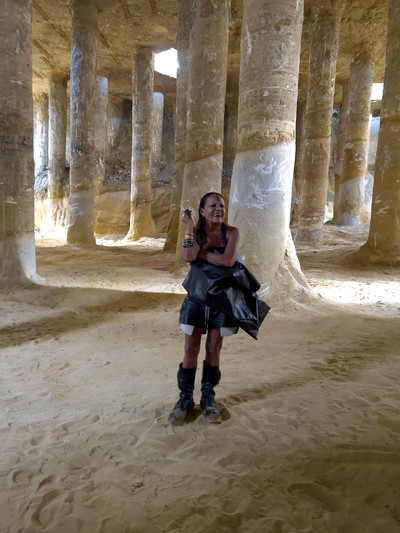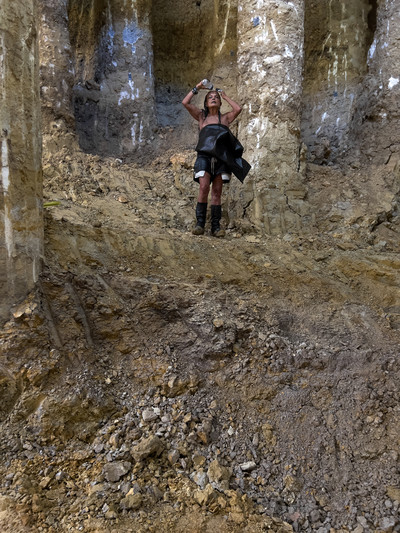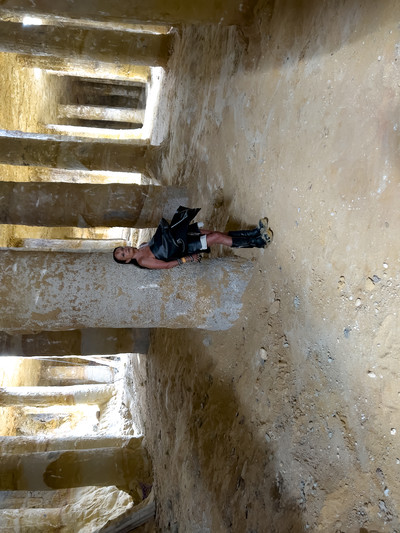Michèle Lamy meets art legend Anselm Kiefer to talk Sappho and New Age dentists.
Interview by Chris Dercon
Photographs by Juergen Teller
Creative partner Dovile Drizyte

Michèle Lamy meets art legend Anselm Kiefer to talk Sappho and New Age dentists.
I first introduced Michèle Lamy to Anselm Kiefer in December 2021. We met in Anselm’s studio in Croissy-Beaubourg, near Paris. During her first visit there, Michèle, dressed and adorned in perfect black as always, was immediately intrigued by Anselm’s Women of the Antiquity series, sculptures cast in white plaster, as well as his huge collection of bird-like white garments arranged on metal racks. A few months later, we sat down for a conversation for System beauty about appearances, beauty, and the beauty of the ugly.
Michèle Lamy: Anselm, I realized that the black on my fingers is because of you. I saw this show with the lead books, in 1984 or 1985.
Chris Dercon: In Los Angeles?
Anselm Kiefer: It’s always frustrating to show books because people cannot turn the pages. So, I made one book accessible so the pages could be turned. It was Siegfried’s Difficult Way to Brünnhilde.
Michèle: It was on a very long rectangular table and I was flabbergasted by the books, and then I heard that you were working with lead so much that it was going to make you sick. I think that made me start painting my fingers.
Chris: That was your first time seeing Anselm’s work, Michèle – when was the second time?
Michèle: It was at the Bibliothèque Nationale and then at the Grand Palais.
Chris: But the first time you met him was here in Croissy? You were flabbergasted when you entered the space and saw all these white dresses of female sculptures.
Michèle: Yes, because I was not expecting them.

Chris: Very few people know how deeply Anselm is interested in these stories of strong women – from ancient times to today.
Anselm: Women played the most important roles in history, politics, and art, but it was not known for a long time. For example, I found out that Sappho, the famous poet, is only known because she is quoted by male poets. Who are your favourite female artists, Michèle?
Michèle: It is difficult to say anyone other than Louise Bourgeois. I cannot think about anybody else that strong, that incredible.
Anselm: She is the most important. What about Camille Claudel? Who else?
Michèle: Yes, Camille Claudel. Lee Bontecou, I love her work. I see something in her work that is like Louise Bourgeois, except Bourgeois is so Freudian and Lee is more abstract.

Chris: When you saw all these sculptures of headless women, and knowing your preference for black, did you wonder why they are all white?
Michèle: I should have asked: ‘Why did you kill them all with a guillotine?’
Anselm: I did not kill them; I just questioned the male urge to prevent women from voicing their thoughts throughout history.
Chris: Why are they all white?
Anselm: I made them in plaster and didn’t want to paint them. Later, they were cast in bronze, but I painted them white because they were originally plaster.
Chris: Anselm, did you ever ask Michèle why she is always dressed in black?
Anselm: No, because it is completely normal. It couldn’t be any other way. She couldn’t be dressed in strange colours; it’s impossible.
Michèle: I just never finished with being a goth, but I like that I am a Halloween figure. Beauty is just a way to express ourselves. Sometimes you see something and you understand there is a beauty that is not conventional.
Anselm: Michèle is beautiful because she fits into any circumstance. There is no corner you wouldn’t fit in; you are the truth that works everywhere.
‘Michèle is beautiful because she fits into any circumstance. There is no corner you wouldn’t fit in; you are the truth that works everywhere.’
Chris: Has the concept of beauty changed radically?
Michèle: Yes, if you look at portraits – rococo, baroque, Renaissance – I wouldn’t say they are beautiful people. They sometimes have a beautiful face, but there is nothing beautiful because it is conventional. It is more about class.
Anselm: We have to distinguish ‘beautiful’ from ‘sexy’. Marilyn Monroe, is she beautiful?
Michèle: That is where we differ, if you think beauty is some kind of aesthetic. I think she was very beautiful because she was expressing herself without thinking she was going to be ridiculous or she was going to be this or that –
she was just doing it.
Chris: The concept of beauty changes all the time, almost overnight or even faster…
Anselm: Not for me. I am a professional – I know what is beautiful and what beauty means to me.
Michèle: My story with beauty starts when I understood what I thought was beautiful – it was the first time I went to North Africa at the age of 16 and I saw some Berber women with tattoos on their faces. I’m sure I recognized it in my subconscious from somewhere in my past; my father’s side came from the Moors eight or ten generations ago.
Anselm: That is so interesting because the first time I saw you in real life, I thought I had seen you in all these photos of Berber women. That crucial meeting with Berber women also influenced your looks.

Chris: Do we still have the classic opposition of beautiful and ugly?
Anselm: It’s still there, so many things are ugly. Go outside and look at architecture; most of it is ugly.
Chris: Can we not find beauty in ugliness? The Elephant Man was ugly, but he also has an incredible beauty. The monsters in Star Wars are ugly, but we want to cuddle them.
Anselm: Yes, that is what I said. You want to investigate things.
Chris: Let’s speak about Michèle’s teeth.
Michèle: I started doing it when we had to change the mercury fillings and I met this New Age dentist in Los Angeles. He wanted to replace them all and mix it with gold to make an alloy. But nothing I wear is jewellery; it is all an accessory.
Anselm: I like this, because it is a sign of a catastrophe.
Michèle: Then I am safe.
Anselm: Distance is good for beauty, too, because it keeps us longing. The ambiguous tension, yet unity of attraction and distance is an essential aspect of beauty.

Chris: We see people on TikTok or Instagram acting out these funny scenes and I call that the grotesque. It is a recognition that we cannot live in the world as we want to, and that we have failed. It is like a weapon to say we want to survive.
Anselm: There has been a long line of beauty through the centuries and I wouldn’t say that there will be another. There is only one beauty for me.
Chris: Which one? That is incredibly Catholic.
Anselm: Yes, but without dogmatism and oppression.
Chris: They put up with so many ugly images because they had one concept of beauty and it took over, lighting up all the others and neutralizing them.
Michèle: For me, beauty is a journey. Things can come and go, but it is all going in the same direction, so I am very persistent in my pursuit of beauty.
Taken from System beauty No. 1 – purchase the full issue here.